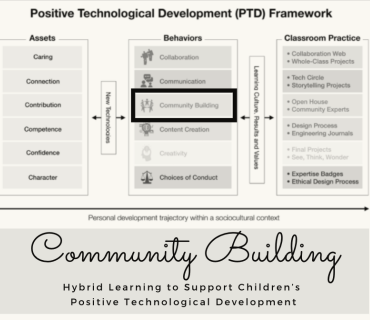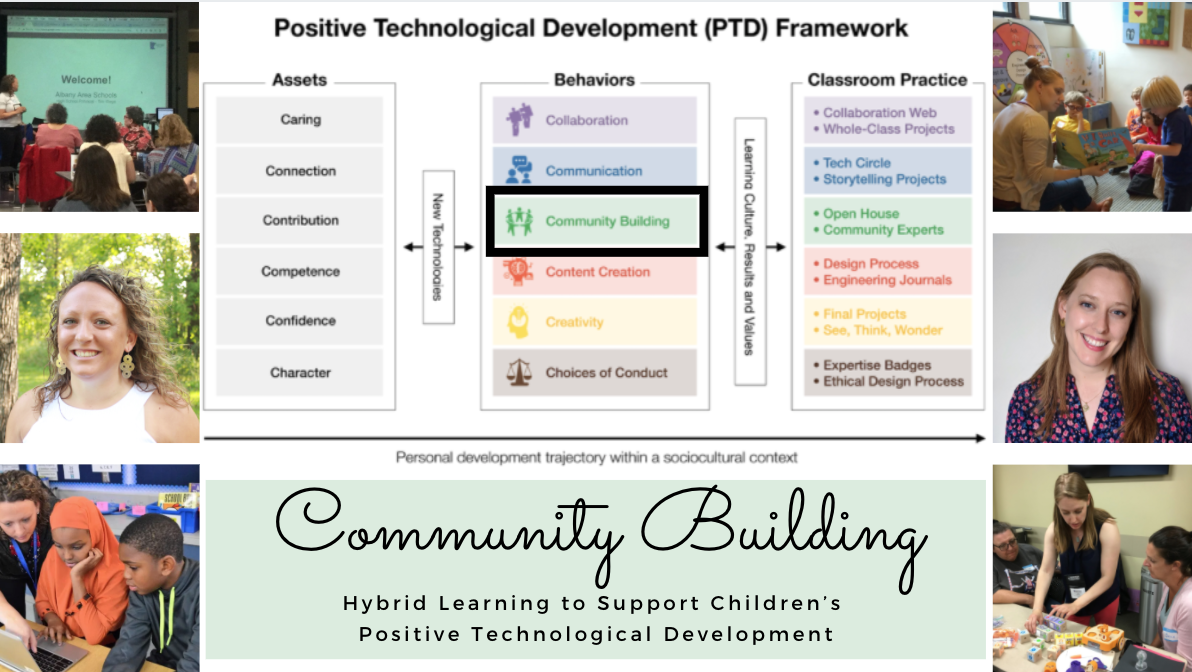
This blog post is the second part of a six-part series of posts about supporting children’s Positive Technological Development through hybrid/distanced learning.
Full Story

This image highlights the Positive Technological Development (PTD) Framework developed by Dr. Marina Bers, and the authors of this blog post, Angie Kalthoff and Dr. Amanda Strawhacker.
In our first post in the series, Introduction, we shared our background in education, our commitment to diversity, equity, and inclusion, and a summary of foundational research in creating a learning experience for young children that aligns with Positive Technological Development framework. In this post, we are going to break down the PTD behavior, “Community Building.” We have invited our friend and colleague, Dylan Portelance, to share a research project centered on supporting students’ listening and speaking skills through project creation and sharing, with the goal of building a supportive learning community.
Community Building
How can technology help us build community?
Community Building is the practice of cultivating a shared space among individuals with a common need or motivation. In the context of early childhood education, children and their teachers share a need to learn and grow, as individuals and as members of their class or school community. In the context of PTD, Community Building is the behavior we see when children are learning how to contribute to their community: to take ownership over problems that arise by offering and enacting solutions and to enhance their community through creative or collaborative work.
Community Building is not a quick process. It takes time and effort from all the members of a community. For educators who are used to physical classrooms, community building in a hybrid learning environment can seem difficult or even impossible. In this post on PTD-aligned hybrid learning, we consider challenges facing classrooms in Fall 2020 and solutions to help you get started right away with Community Building. These practices are useful for creating a community during this year’s unique distanced education, but more generally, anytime children are invited into digital learning environments. Building community with students allows them to feel safe and free to play with new friends and new ideas. This playful mindset will make it much easier for them to explore all the other PTD behaviors in your class this year!
Research on PTD and Community Building
How can we have the same kinds of organic conversations in a hybrid learning setting that we would normally have during in-person circle time?
As described by Dr. Bers in her book Coding as a Playground, Community Building is fostered through mechanisms that promote a sense of connection between peers or with adults (Bers, 2020). One example of a way to build community is through technology circles. Circle time is a classic early childhood conversation structure, in which all members of the class community (including adults) gather in a circle on a carpet or low chairs, to have open conversations. We understand that while teaching during a pandemic you may not be able to gather together on a carpet in a circle and will share additional resources we think you may find useful to facilitate these conversations from a distance both in-person and online.
Technology circles are special circle times dedicated to the process, rather than the outcome, of children’s technology explorations. Children can use Tech Circle Time to ask questions they have about technologies or activities, share frustrations and ask for feedback, and solve issues together as a community. During in-person tech circles, you can help children focus on the conversation by creating a separate area to store the technology, such as a robot or tablet “parking lot”, or by asking children to place projects and tools behind their backs (Bers 2017, p. 179). With hybrid tech circles, you might invite children to focus on the conversation by asking adult supervisors to close any additional tabs on their screen, and keep robots in a different room. If children have trouble focusing, you might allow them to use a pre-approved “fidget toy”, like a sensory block or a small lump of play-doh, to help them maintain focus without the sensory stimulation of other children nearby. To cover all important ideas without losing the children’s attention, these discussions might be broken up and held throughout the day or the week, rather than all at once. In general, Zoom tech circles should not last longer than 10-15 minutes at a time. If you would like to learn more about effective classroom practice with school-age children, we recommend reading this NAEYC article. Families may be interested to read about these screen time guidelines from the APA.
When you think about the space you are creating both virtually and in-person take a few of these into consideration to support community building:
- How can children use the technology to represent meaningful people, places, experiences, or customs in their lives?
- How can children create projects with technology to help others in their classroom?
- How can children create open-ended projects that others can build upon or change? How can you prepare children to allow their work to be reinterpreted by others while respecting their creative freedom?
- How is children’s work celebrated in the community space?
As you think about more ways to build community in your learning environment, at home or school, consider the following question prompts from the PTD card deck (a tool created by Dr. Bers to help educators align their technology teaching with PTD).
Community Building in Context
Why does school look so different this year? Why is Community Building important for your students?
Remember that children in your class community may come from a variety of diverse and varied backgrounds and experiences. The goal of community building is to help children find common ground, and from there, build connections and trust. In Culturally Responsive Teaching & The Brain, Zarette Hammond shares “Selective Vulnerability” as a trust generator. This is done when “people respect and connect with others who share their own vulnerable moments. It means showing your human side that is not perfect” (p.80). In the context of a classroom, this might look like sharing a challenge you are having as a teacher or as a learner, and acknowledging how it is hard for you (mentally, emotionally, physically, or otherwise). To read more on this topic, visit www.circleducators.org where Angie has been thinking and writing with other educators on this topic. Also, keep in mind that the information you share should be selective and appropriate for the cognitive and emotional development of the children you work with.
One obvious area of common ground for everyone in 2020 is the experience of the global COVID-19 pandemic, and children may wish to explore that shared experience with their classroom community. If you are wondering whether or how to talk about COVID with your students this year, we invite you to remember a favorite Mister Rogers’ quote: “Anything that’s human is mentionable, and anything that is mentionable can be more manageable. When we can talk about our feelings, they become less overwhelming, less upsetting and less scary” (PBS.org, 2020). If you are planning to teach about COVID in your classroom, what can you share about COVID in your life to show your vulnerability and human side? There are many great resources for educators to use when educating students about COVID-19, like this PebbleGo article in English and Spanish. To see additional resources appropriate for young children, visit the Tufts DevTech ECT Graduate Certificate website.
As we begin the 2020-2021 school year, many of us are experiencing a first day of school like never before. Teaching and learning during a pandemic is a new experience for all of us. Many of these changes can be overwhelming and anxiety-provoking. One of the positive changes is that you may be able to welcome family members into your class community in a richer way than you could before. Families will have many professional and personal constraints to balance, but you can set the tone for an inclusive classroom by consistently finding ways to welcome them into activities or sharing ideas they can use to support children’s learning with technology throughout the year.
Using Tech to Build Community
How do we create a class community and get to know each other?

This image shows a visual summary of the EdTech Community Building activities described in this post.
Here are some simple activity starters to get you thinking about ways to use technology to build your class community from home or school.
One note to consider is how you will talk to children about hybrid/distanced learning environments. As adults, we often use the terms synchronous vs asynchronous to describe when learning is happening in an online environment. Are these terms developmentally appropriate for young children? You might consider replacing synchronous with words like live, happening now, or together, and replacing asynchronous with on-demand, happening later, or on your own.
Family Tip: Think about how you will communicate with families, and what tech access they may have. For some of the activities below, alert families that children may need help from an adult to use these EdTech tools. For example, you can direct adults to the ScratchJr Learn website to explore the ScratchJr interface.
Activities for Building Classroom Community From Home.
ScratchJr Pen Pals. Pair children in your class to be Pen Pals! After children have explored ScratchJr on their own, have everyone create an “All About Me” project to share with their Pen Pal(s) and teacher. (For inspiration, check out this ScratchJr Self-Portrait activity guide from the DevTech Research Group.) Host a tech circle to help children troubleshoot issues and gather ideas. Give children more time to revise their projects if needed, and then invite them to share their projects with their Pen Pals. Some suggested sharing strategies are:
- Share a ScratchJr project: Have children share their projects to their Pen Pal partner using the ScratchJr app Sharing feature. Pen Pals can open projects in their own ScratchJr app, and can even remix or edit them and re-share!
- Share a Seesaw Recording of a ScratchJr project: As a teacher, you can organize this project by creating an “Activity” in Seesaw. Students can share their videos in the Seesaw Activity and their PenPal can comment via text and/or voice.
- Share a Flipgrid Recording of a ScratchJr project: Students can upload their ScratchJr video to a Flipgrid “Topic”. Pen Pals can leave a video comment in Flipgrid.
Students can be partnered with Pen Pals for one activity or can continue to share projects back and forth for a week or a time period of your choice. Switch Pen Pals throughout the unit or the year, until children have had a chance to meet everyone in their classroom.
Building Classroom Community From School:
ScratchJr Safety Stories. Code a story about how your class can stay safe from COVID or a community health interest of your choice. You might use these activities to guide a conversation about “Community Agreements”, ways that your students agree to keep their community safe.
- Reflector: Have students share their screen to the classroom projector to show off their project in a way that is easy for everyone to see (even from distanced seats around the room). Invite children to treat this story as a presentation. You can even have dress rehearsals and talk about writing a script to help their communication and presentation skills!
- Flipgrid: Pair students to make “Code and Tell Interviews” (see summary below), where children talk to each other about the projects they made, and share how they made it. Have children take turns asking one question about their partner’s project.
Guest Contribution: Code and Tell by Dylan Portelance: Code and Tell is an activity used for integrating coding with speaking and listening for early elementary grades. Designed to be paired with a curriculum where students create projects using ScratchJr, Code and Tell allows students to further explore each others’ projects through “peer interviewing.” Students form pairs then take turns asking a series of interview questions-three are scripted and one of their choice. For an in-class implementation, one student can show and talk about their project while the other student interviews their partner and records video using their device’s camera. The students then switch. This activity can also be adapted for remote learning, using Zoom or another video-conferencing application. Teachers can use these artifacts for the assessment of both computational thinking skills and ELA. Check out my research article to learn how peer interviews supported children’s Computational Thinking skills, and to read my suggestions for best practices to get started with Code and Tell in the classroom.
Code and Tell Questions for Students:
- Tell me about your project.
- How did you make your project?
- What would you do if you had more time?
- Question of student interviewer’s choice
How are you Building Community in your classroom this year?
We want to hear your creative ideas about helping students in your class build relationships of trust and caring. Share your thoughts with us on social, and follow along for updates about this series and other resources on education:
Share on Facebook: @TuftsECT
Share on Twitter: @TuftsECT
About the Authors
 Dylan Portelance is an EdTech product manager currently working on Wonder Workshop’s K-5 coding and robotics platform with Dash and Dot. He holds an MA in Child Development and a BS in Computer Science from Tufts University, where he was a graduate researcher with the ScratchJr Team. Connect with Dylan on Twitter: @DJportel
Dylan Portelance is an EdTech product manager currently working on Wonder Workshop’s K-5 coding and robotics platform with Dash and Dot. He holds an MA in Child Development and a BS in Computer Science from Tufts University, where he was a graduate researcher with the ScratchJr Team. Connect with Dylan on Twitter: @DJportel Angie Kalthoff is the Product Manager for Curriculum and Instruction at Capstone. Over her career, she has been an English Language (EL) teacher, Technology Integrationist, Program Manager, and University Instructor. She has an M. Ed in Teaching and Learning. Connect with Angie on Twitter: @mrskalthoff and visit her website: bit.ly/angiekalthoff.
Angie Kalthoff is the Product Manager for Curriculum and Instruction at Capstone. Over her career, she has been an English Language (EL) teacher, Technology Integrationist, Program Manager, and University Instructor. She has an M. Ed in Teaching and Learning. Connect with Angie on Twitter: @mrskalthoff and visit her website: bit.ly/angiekalthoff. Amanda is the Associate Director of the Early Childhood Technology (ECT) Graduate Certificate Program at Tufts University’s Eliot-Pearson Department of Child Study and Human Development. She holds a Master’s and Ph.D. in Child Study and Human Development, which she earned while designing and researching EdTech like ScratchJr and the KIBO Robot at the DevTech Research Group, and was a speaker with TEDxYouth@BeaconStreet. Connect with Amanda on Twitter: @ALStrawhacker and visit her website: amandastrawhacker.com
Amanda is the Associate Director of the Early Childhood Technology (ECT) Graduate Certificate Program at Tufts University’s Eliot-Pearson Department of Child Study and Human Development. She holds a Master’s and Ph.D. in Child Study and Human Development, which she earned while designing and researching EdTech like ScratchJr and the KIBO Robot at the DevTech Research Group, and was a speaker with TEDxYouth@BeaconStreet. Connect with Amanda on Twitter: @ALStrawhacker and visit her website: amandastrawhacker.com
